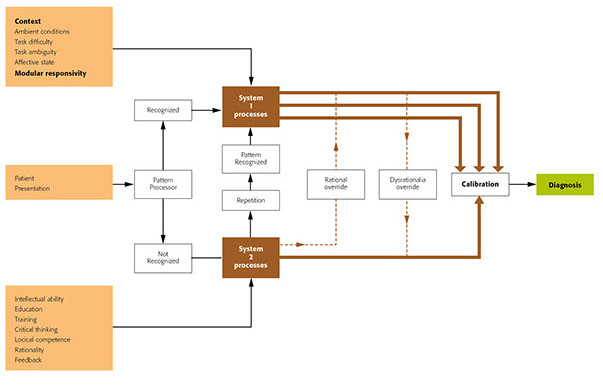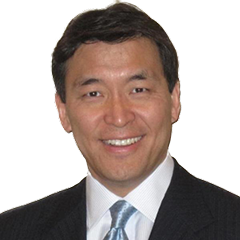
![]() Back to contents
Back to contents
Clinical decision making—
a critically important skill
Clinical decision making uses a unique psychological process that involves deep knowledge of pathological conditions, input by patients and experiential learning. The advent of clinical support tools and technologies may help to make more informed decisions, with fewer diagnostic errors, leading to better outcomes.

AO Surgery Referene is an awarding winning online repository of surgical knowledge to facilitate surgeon decision making. Users can access targeted literature, as well as AO course videos for numerous deformity and spinal procedures.
Clinical decision making (CDM) is arguably one of the most important aspects of a physician's job. The psychology behind how doctors arrive at clinical decisions has not, for the most part, been well understood, studied, or taught, and it is only in the last two decades that the topic has really started to gain prominence.
The publication of Jerome Groopman’s bestseller How Doctors Think in 2007 brought the issue to the forefront for doctors and the public alike and spawned numerous publications on CDM. It was also around this time that researchers began to put together a cohesive model of CDM that incorporates two older models; the intuitive, heuristic model and the information processing or systematic, analytical model.
Merging models
The intuitive, heuristic model of CDM is based principally on the experience of the doctor, his or her ability to recognize patterns, and the intuition that develops from those experiences. Intuition has been defined as “understanding without rationale” and is strongly correlated with experience. While the advantages of this approach are that it is automatic and fast, it is also more unreliable and can be associated with more error.
In contrast, the information processing or systematic, analytical model of CDM is based on hypothetico-deductive reasoning and assumes that the thought process follows rational logic. This model of CDM involves hypothesis testing, deductive reasoning, and critical thinking and takes place with greater resources for the decision maker. The systematic, analytical model is very robust and results in less uncertainty, but is also a slower process.
A comparison of the intuitive, heuristic and the systematic, analytical models of Clinical Decision Making
Intuitive, Heuristic
Hypothetico-deductive
Bounded rationality
Heuristic
Gestalt effect/pattern recognition
Modular (hard-wired) responsivity
Recognition-primed/thin slicing
Unconscious thinking theory
Systematic, Analytical
Hypothetico-deductive
Unbounded rationality
Normative reasoning
Robust decision making
Acquired, critical, logical thought
Multiple branching, arborization
Deliberate, purposeful thinking
Source: Croskery, P (2009) Academ. Med. v.84, no.8, 1022-1028.
Current thought on CDM
The dual processing model is currently the most prevalent approach to CDM. It can be interpreted as a combination of the intuitive, heuristic model (called system 1 reasoning) and the systemic, analytical model (called system 2 reasoning). In the dual processing model, a doctor can shift between system 1 and system 2 thinking. It is a fluid process in which either type of processing can override the other at any point.
The system of processing used can also be situationally dependent. Some factors that can influence which system is used are: time available, complexity of diagnosis, severity of illness, and the physical and mental state of the doctor.
Other disciplines have started to recognize the importance of environment on the decision making process. This is important in medicine as well, for example, the areas of the brain that are compromised through sleep deprivation are the same areas that are responsible for system 2 reasoning.
Root of diagnostic errors
Some studies have shown that it is an overreliance on one system of thinking that causes diagnostic errors and that learning to use additional systems of processing (as in the dual processing model) can increase diagnostic accuracy. This also requires metacognition (thinking about your thinking) and for a doctor to be self-critical and willing to re-evaluate when one type of thinking is not working.
The dual process model of clinical decision making (Click to zoom)

The model goes from left to right, beginning with the physician either recognizing or not recognizing the presentation of an illness or condition. Either system of processing can override the other at any point.
Source: Croskery, P (2009) Academ. Med. v.84, no.8, 1022-1028.

Value-based spine care
AOSpine North America supported the recent publication of a SPINE journal Focus Issue on value-based spine care.
The issue explored the key concepts related to defining value in health care, economic reviews on surgical spine care, and the application of registries and clinical pathways as means to improve value in spine care.
To learn more about this important issue, click here.

A KLAS report identified five elements of clinical decision support tools that have the greatest positive impact on healthcare:
- Order sets
- Multi-parameter alerting
- Nursing care plans
- Reference content
- Drug information databases
source: KLAS Enterprises, Clinical Decision Support: Striving for More Intelligent Care 2010
Involving the patient
Shared decision making, where clinicians and patients work together to make decisions (most often, treatment decisions) is quickly becoming standard practice in many disciplines. Studies have shown that shared decision making can lead to improved patient outcomes, satisfaction, medication adherence, and sometimes improved clinical outcomes.
While there is a continuum of possibilities as to how much input a patient can have in the decision process, it is important that patient preferences guide the approach used. This requires clear communication, active listening, and dedicated time.
Decision support tools
The expansion of information technology and medical research has led to an explosion in clinical decision support tools. These tools, along with electronic health records, can create a powerful process to help support clinicians throughout the process of decision making. A recent report from the Agency for Healthcare Research and Quality (US department of health and human sciences) describes clinical decision support as follows:
In most cases, clinical decision support systems match patient-specific information (eg. current medication regimen, a recent laboratory result) to an evidence-based clinical knowledge set (eg. known drug interactions, clinical contraindications), and then generate customized assessments or recommendations that can be communicated to clinicians in a variety of ways (eg. via alerts or recommendations, order sets, documentation templates, reminders, and retrospective feedback, including comparisons of performance to benchmarks and lists of patients who need services).
The structured data necessary for effective clinical decision support can also be used for clinical quality measurement and feedback, creating an integral linkage between these processes in the design and use of clinical data systems. When effectively implemented, clinical decision support systems can provide information and context to support patient-centered, evidence-based clinical decisions.
Clinical decision support tools are beginning to delve into many aspects of care including personalized medicine, clinical analytics, and natural language processing. The ability of healthcare organizations to analyze patterns in their patient populations enables them to provide personalized medicine and work proactively to avoid complications and problems.
Clinical decision support tools for sepsis and re-admission risk assessments have both shown promising results. A study in Canada found that using a clinical decision support tool to determine length of hospital stay targets for patients after spinal cord rehabilitation resulted in a 17% reduction in length of hospital stay and a 16% increase in Functional Independence Measure.
Choosing the right tool
There are so many diagnostic tests that it can be difficult for clinicians to find the right test for the right patient; enter clinical analytics. Even very basic data collection features, such as sending reminders to patients, can be helpful. Clinical analytic tools can improve quality of care, reduce waste, and enhance value.
A study examining lumbar spine MRI use in adult primary care patients with low back pain found that the use of a clinical decision support analytic tool resulted in a 32% decrease in MRI use while improving guideline-adherent practices. Considering increasing cost of spine care and number of patients (especially in the US), the importance of value-based spine care cannot be underestimated.
Speaking the same language
Natural language processing is a stumbling block in many fields. Computers and people don’t always speak the same language even if they are both using English; just think of the awkwardness of conversing with Siri on your iPhone.
Clinical decision support systems in the areas of natural language processing typically involve using computers to examine electronic health records or other documentation to pull out medically relevant information. WellPoint uses IBM’s Watson supercomputer to assist in natural language processing to help make decisions about treatment requests and plans more quickly. Isabel Healthcare also has a system that can help clinicians by providing an analysis of a patient’s record, pulling information and data directly from the electronic health record.
Despite the relatively recent inception of CDM theories, models, and tools, the choices are numerous. The challenge is deciding which to use at any given time; it is a balancing act. The importance of metacognition for novice and experienced clinicians alike is key to successful CDM and patient outcomes.
 “The more experience you have, the less you need to rely on a predetermined process.”
“The more experience you have, the less you need to rely on a predetermined process.”
AOSpine discussed "Clinical Decision making" (CDM) with Daniel Riew, Director of the Cervical Spine Institute at Washington University School of Medicine, USA.
How do you use clinical decision making in your daily practice?
Probably the most important thing for me in terms of CDM is relying on my experience. I've been in practice for 20 years and because I only see adult patients with cervical spine problems, I've seen tens of thousands of patients with similar problems. I think what happens when you first start out in practice is that you need algorithms, guidelines, and to look at the literature to try to figure out what to do. But now, I don't need a checklist or guidelines to tell me what works and what doesn’t work. I think that the more experience you have, the less you need to rely on a pre-determined process.
Clinical decision support technologies are developing rapidly. What do you think their future direction might be?
I think that the wave of the future is technology and, without a doubt, having these technological tools at one's disposal will be invaluable. It will be especially helpful to the young, inexperienced surgeons just starting out because these tools are designed to help with clinical decision making skills; what comes naturally and intuitively to an experienced surgeon comes only after years of doing the same thing over and over again. These tools can be enormously helpful to surgeons just starting out. Eventually all that information becomes a part of you and you no longer have to consult tools to tell you what to do because the answer is already imbedded inside your brain.
Do you know of any decision making tools being developed that might be a game changer for spine surgery?
I don't know if anything is going to be a game changer, but if you were to look at the landscape again in 5 years, I have no doubt that we will have a lot more computerized CDM algorithmic tools at our disposal. Development of these resources is being done by many different organizations, surgeons and universities. The wonderful news is that these tools will be available to young surgeons and hopefully, this will help with the transfer of knowledge from the experienced to the inexperienced surgeon without having to spend years on training.
—
ABOUT Daniel Riew, MD
The Chief of Cervical Spine Surgery for Washington University Orthopedics, Dan Riew is also the Mildred B Simon Distinguished Professor of Orthopedics and Professor of Neurological Surgery. He has been Chair of the AOSpine Research Commission from 2012 to 2015 and is the incoming Chair of AOSpine International.
The articles published in this newsletter reflect the opinions of the writers only and not those of AOSpine
